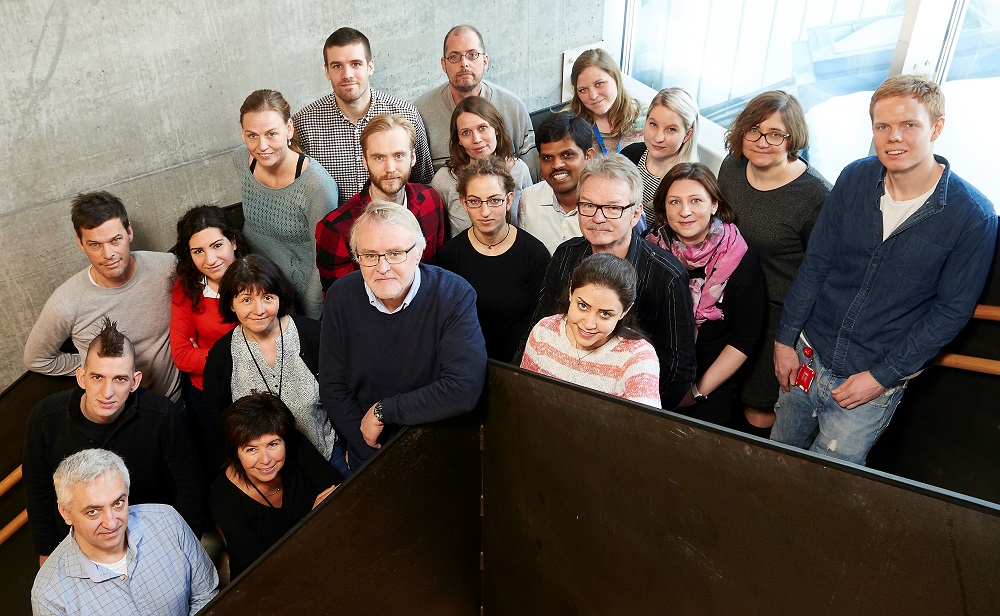The Inflammation Research Group - CEMIR
The Inflammation Research Group

The strategy of the Inflammation Research Group is to study the cellular and molecular mechanisms that inflammasomes, Toll-like receptors (TLRs) and the complement system are using to mount sterile and non-sterile inflammatory responses.
The group has a long track record and has made several significant contributions within innate immunity and host defence over the last 25 years. Currently, we have a focus on mechanisms involved in trafficking of TLRs and their adaptor molecules between intracellular compartments where TLR signalling is taking place.
This project aims to increase our understanding of how Gram-negative - and Gram-positive bacteria are able to induce inflammatory signalling from different cellular compartments, and identify new targets for treatment of severe inflammatory conditions. Moreover, we work on inflammatory responses that occur during the development of atherosclerosis. The aim of this project is to identify the detailed molecular mechanisms of how cholesterol crystals activate the complement system and immune cells. The goal is to design effective therapeutic agents to diagnose and treat atherosclerosis.
The Inflammation Research Group has a strong interest in applying and developing molecular and cellular imaging techniques for use in the CEMIR projects. The group leader is also scientific leader for the Cellular and Molecular Imaging Core Facility (CMIC) at NTNU. This core facility has recently acquired the most recent state of the art 3X STED super-resolution laser confocal microscope with a PicoQuant single molecule detection upgrade, and a TIRF microscope. Both these instruments have been installed in the new CEMIR laboratories.
Research documentation
10 selected publications
10 selected publications
- Zimmer, S., A. Grebe, S. S. Bakke, N. Bode, B. Halvorsen, T. Ulas, M. Skjelland, D. De Nardo, L. I. Labzin, A. Kerksiek, C. Hempel, M. T. Heneka, V. Hawxhurst, M. L. Fitzgerald, J. Trebicka, I. Bjorkhem, J. A. Gustafsson, M. Westerterp, A. R. Tall, S. D. Wright, T. Espevik, J. L. Schultze, G. Nickenig, D. Lutjohann, and E. Latz. 2016. Cyclodextrin promotes atherosclerosis regression via macrophage reprogramming. Sci Transl Med 8: 333ra350
- Bergstrom, B., M. H. Aune, J. A. Awuh, J. F. Kojen, K. J. Blix, L. Ryan, T. H. Flo, T. E. Mollnes, T. Espevik, and J. Stenvik. 2015. TLR8 Senses Staphylococcus aureus RNA in Human Primary Monocytes and Macrophages and Induces IFN-beta Production via a TAK1-IKKbeta-IRF5 Signaling Pathway. J Immunol 195: 1100-1111.
- Klein, D. C., A. Skjesol, E. D. Kers-Rebel, T. Sherstova, B. Sporsheim, K. W. Egeberg, B. T. Stokke, T. Espevik, and H. Husebye. 2015. CD14, TLR4 and TRAM Show Different Trafficking Dynamics During LPS Stimulation. Traffic 16: 677-690.
- Nilsen, N. J., G. I. Vladimer, J. Stenvik, M. P. Orning, M. V. Zeid-Kilani, M. Bugge, B. Bergstroem, J. Conlon, H. Husebye, A. G. Hise, K. A. Fitzgerald, T. Espevik, and E. Lien. 2015. A role for the adaptor proteins TRAM and TRIF in toll-like receptor 2 signaling. J Biol Chem 290: 3209-3222.
- Franklin, B. S., L. Bossaller, D. De Nardo, J. M. Ratter, A. Stutz, G. Engels, C. Brenker, M. Nordhoff, S. R. Mirandola, A. Al-Amoudi, M. S. Mangan, S. Zimmer, B. G. Monks, M. Fricke, R. E. Schmidt, T. Espevik, B. Jones, A. G. Jarnicki, P. M. Hansbro, P. Busto, A. Marshak-Rothstein, S. Hornemann, A. Aguzzi, W. Kastenmuller, and E. Latz. 2014. The adaptor ASC has extracellular and 'prionoid' activities that propagate inflammation. Nat Immunol 15: 727-737.
- Samstad, E. O., N. Niyonzima, S. Nymo, M. H. Aune, L. Ryan, S. S. Bakke, K. T. Lappegard, O. L. Brekke, J. D. Lambris, J. K. Damas, E. Latz, T. E. Mollnes, and T. Espevik. 2014. Cholesterol crystals induce complement-dependent inflammasome activation and cytokine release. J Immunol 192: 2837-2845.
- Husebye, H., M. H. Aune, J. Stenvik, E. Samstad, F. Skjeldal, O. Halaas, N. J. Nilsen, H. Stenmark, E. Latz, E. Lien, T. E. Mollnes, O. Bakke, and T. Espevik. 2010. The Rab11a GTPase controls Toll-like receptor 4-induced activation of interferon regulatory factor-3 on phagosomes. Immunity 33: 583-596.
- Duewell, P., H. Kono, K. J. Rayner, C. M. Sirois, G. Vladimer, F. G. Bauernfeind, G. S. Abela, L. Franchi, G. Nunez, M. Schnurr, T. Espevik, E. Lien, K. A. Fitzgerald, K. L. Rock, K. J. Moore, S. D. Wright, V. Hornung, and E. Latz. 2010. NLRP3 inflammasomes are required for atherogenesis and activated by cholesterol crystals. Nature 464: 1357-1361.
- Husebye, H., O. Halaas, H. Stenmark, G. Tunheim, O. Sandanger, B. Bogen, A. Brech, E. Latz, and T. Espevik. 2006. Endocytic pathways regulate Toll-like receptor 4 signaling and link innate and adaptive immunity. Embo j 25: 683-692.
- Latz, E., A. Schoenemeyer, A. Visintin, K. A. Fitzgerald, B. G. Monks, C. F. Knetter, E. Lien, N. J. Nilsen, T. Espevik, and D. T. Golenbock. 2004. TLR9 signals after translocating from the ER to CpG DNA in the lysosome. Nat Immunol 5: 190-198.
Collaboration
National
- Tom Eirik Mollnes, University of Oslo
- Pål Aukrust, University of Oslo
- Bente Halvorsen, University of Oslo
- Harald Stenmark, University of Oslo
International
- Egil Lien, University of Massachusetts, USA
- Kate Fitzgerald, University of Massachusetts, USA
- Claudia Kemper, NIH, USA
- Eicke Latz, University of Bonn, Germany
- Peter Garred, University of Copenhagen, Denmark
- Guiseppe Teti, University of Messina, Italy
- Mary McCaffrey, University of Cork, Ireland
